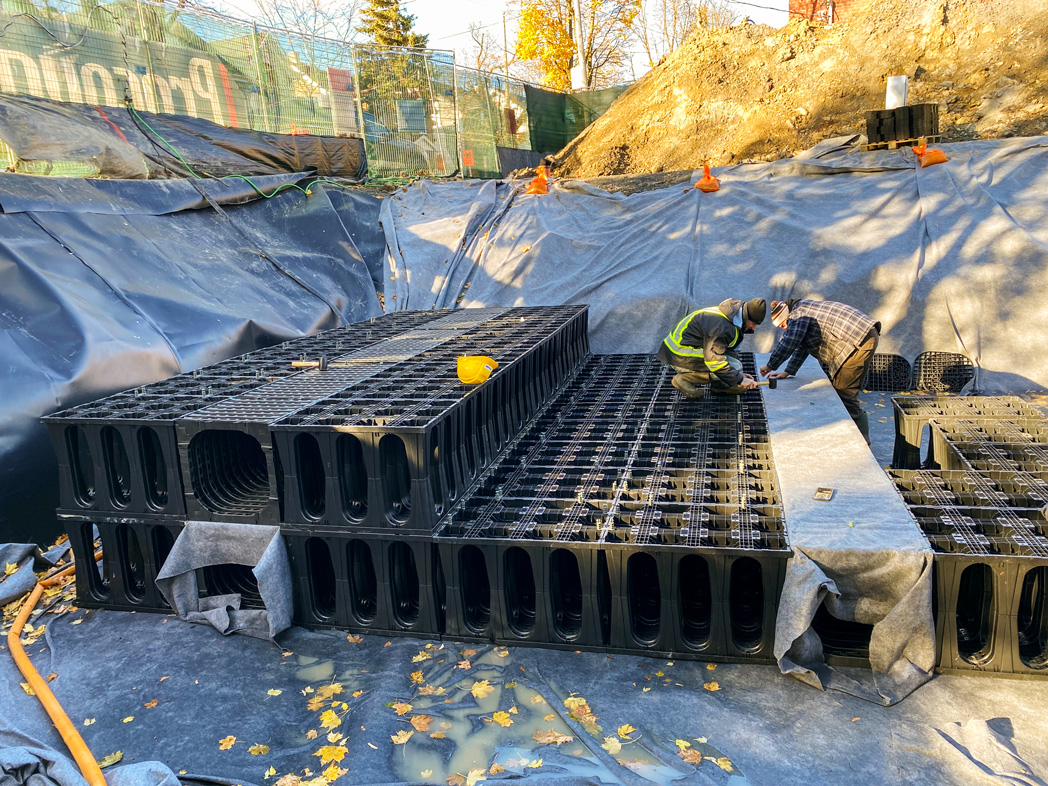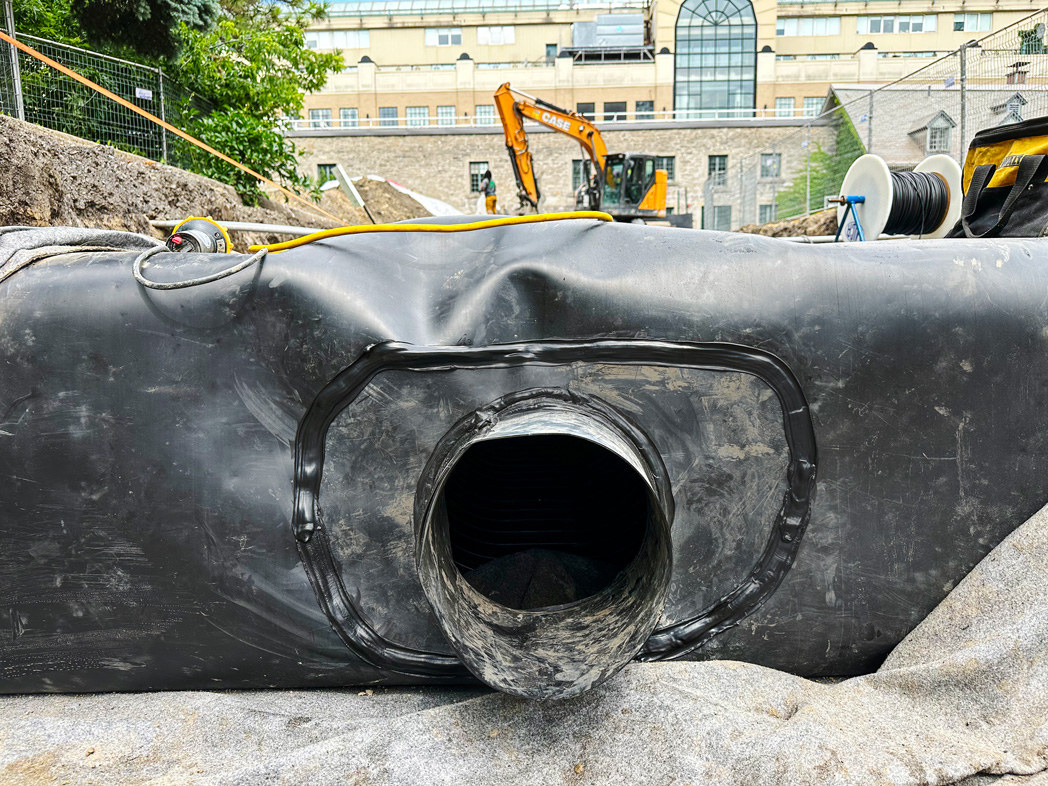Stormwater Retention Systems:
What They Are & How They Work
Stormwater Retention Systems:
What They Are & How They Work

<p><em>Installation of a BG-AQUA citybloq retention system </em></p>
<p>A <strong>stormwater retention system</strong> collects and stores excess surface runoff between storm events. Water retention systems maintain a constant pool of water between runoff events. The water collected is forced out and entirely or partially replaced by surface runoff from subsequent rain events.</p><p>Retention systems have revolutionized traditional stormwater management practices within urban landscapes. This article will discuss stormwater management solutions, including modular, heavy-duty systems that offer enhanced water retention, detention, and infiltration.</p><p> </p><p><strong>Table of contents</strong></p><ul><li>What is Retention?</li><li>What is Infiltration?</li><li>Differences Between Retention and Infiltration Systems</li><li>What is a Stormwater Retention System?</li><li>How Do Water Retention Systems Work?</li><li>The Importance of Rainwater Retention</li><li>Retention Systems for Surface Sealing</li><li>Retention Systems to Prevent Flooding and Property Damage</li><li>What Characteristics Should Water Retention Systems Meet?</li><li>Rainwater Retention with BG-Graspointner</li></ul><p> </p><h2><span class="text--medium"><strong>What is Retention?</strong></span></h2><p><a href="/en-us/bg-blog/sustainable-rainwater-management">Sustainable rainwater retention systems</a> collect and store surface runoff for the long term. Retention systems maintain a permanent volume of water between rainfall events. Typically, water can only leave these systems if it is displaced by subsequent runoff, pumped out for use, evaporates, or infiltrates the soil.</p><p>While retention systems focus on holding water, stormwater detention systems temporarily collect and gradually release it after storms, making them suitable for areas with spatial limitations or intense rainfall. Detention systems are often installed under urban hardscapes like parking lots and athletic fields. </p><p> </p><h2><span class="text--medium"><strong>What is Infiltration?</strong></span></h2><p>Infiltration is the process through which water absorbs into the soil, replenishing groundwater reserves. Infiltration systems are designed to support this natural mechanism by allowing stormwater to soak into the ground rather than being collected or discharged. These systems are essential for boosting groundwater levels and preserving ecological stability. Unlike retention systems, which store water, infiltration systems prioritize soil absorption, contributing to sustainable water management.</p><p> </p><h2><span class="text--medium"><strong>Differences Between Retention and Infiltration Systems</strong></span></h2><p>Retention and infiltration systems serve distinct purposes in stormwater management. Understanding the differences between these systems allows drainage designers to build solutions that align with the needs of specific sites. While retention systems are designed for water storage, infiltration systems focus on facilitating natural infiltration.</p>

<p>Welding of a geomembrane onto a rainwater retention system</p>
<p>Retention systems incorporate geomembranes to block water from seeping into the surrounding soil, ensuring a constant water pool. In contrast, infiltration systems utilize geotextiles to facilitate water absorption into the soil, aiding groundwater recharge.</p><p>Both systems play a crucial role in managing stormwater runoff, particularly <strong>in urban areas with extensive hardscape surfaces.</strong> Retention methods, such as bioretention and underground storage, can work alongside infiltration systems to create a holistic approach to sustainable stormwater management. Recognizing these differences enables designers to develop tailored solutions that balance water storage and soil infiltration, ensuring the best environmental outcomes.</p><p> </p><h2><span class="text--medium"><strong>What is a Stormwater Retention System?</strong></span></h2><p>A stormwater retention system employs drainage strategies and systems to control the volume and quality of stormwater runoff. This arrangement allows urban authorities to minimize flooding, prevent erosion, and limit pollution during high rainfall events.</p><p>Key benefits of stormwater retention systems include:</p><ul><li><strong>Flood Risk Reduction:</strong> Effective surface runoff management prevents excess water pooling that leads to flooding.</li><li><strong>Water Quality Improvement:</strong> Bio-retention facilities, permeable pavement systems, and rain gardens filter pollutants from runoff.</li><li><strong>Sustainable Practices:</strong> Modern strategies blend green infrastructure, refining urban landscapes and biodiversity.</li><li><strong>Regulatory Compliance:</strong> Construction projects must comply with environmental policies protecting water bodies.</li></ul><p>Stormwater management is a low-maintenance, efficient, and eco-friendly response to urban expansion and climate change. Let's explore how that works in more detail.</p><p> </p><h2><span class="text--medium"><strong>How Do Water Retention Systems Work?</strong></span></h2><p>A <strong>modular stormwater retention system</strong> provides dedicated storage for excess runoff from hardscape surfaces, including rooftops, streets, and parking lots. Control units limit the peak flow of water into public networks—curbing the risk of overflows and flooding. The system collects water from <a href="/en-us/bg-blog/what-are-trench-drain-systems">trench drains</a>, <strong>manholes, or catch basins</strong> and conveys it into the retention systems through a pipe network.</p><p>Stormwater management systems generally include subsurface storage, above-ground, and vertical/horizontal <strong>modular tanks.</strong> A typical setup consists of a sump unit (manhole) that connects to the inlet trench drain and the modular retention system, primarily via a pipe. </p>

<p>Pipe connection (inlet/outlet) of a retention system</p>
<p>Water collects inside the attenuation system and fills the empty retention structure. An <strong>air vent</strong> limits air pressure build-up by allowing displaced air to escape, while an <strong>outlet sump pump</strong> at the periphery may also release excess water, facilitating controlled overflow management.</p><p>The collected water can infiltrate the ground (if utilizing a permeable system) or gradually drain into the storm sewer network at a delayed rate to curb downstream flooding (if using a geomembrane).</p><p> </p><h2><span class="text--medium"><strong>The Importance of Rainwater Retention</strong></span></h2><p>Rapid urbanization, extreme rainfall exacerbated by climate change, the need for sustainable infrastructure, and stringent stormwater management guidelines all drive the adoption of retention systems.</p><p>The reason is simple: <strong>rainwater retention systems reduce flooding by managing stormwater runoff. </strong></p><p>Rainwater retention diverts, captures, and holds surface runoff that might otherwise enter local water bodies or municipal sewer systems. It prevents sewers, streams, and rivers from being over-inundated with water, limiting the risk of overflow and flooding.</p><p> </p><p><strong>Benefits of installing modular stormwater tank management systems include:</strong></p><ul><li>Flexibility in design to fit multiple spaces/locations</li><li>Space-saving design for efficient space utilization vis-à-vis traditional solutions</li><li>Ease of installation due to modular components</li><li>High storage capacity</li><li>Low maintenance needs</li><li>Improved water quality: geocellular storage systems use filters to help remove debris and sediments before reuse.</li></ul><p> </p><p>Retention systems also <strong>scale efficiently.</strong> Modular designs allow tailored solutions to meet project needs, from small residential developments to large commercial sites. Users can add or eliminate modules as required.</p><p> </p><h3><span class="text--medium">1. Retention Systems for Surface Sealing</span></h3><p>Rapid urban development compromises the ability of rainwater to infiltrate the soil. As a result, extreme rainfall events raise flood risks significantly. In this context, retention systems are becoming crucial. Many projects rely on retention systems to avert flooding and property damage.</p><p> </p><h3><span class="text--medium">2. Retention Systems to Prevent Flooding and Property Damage</span></h3><p>Excess rainfall in a short period overwhelms sewer networks as drainage systems reach their capacity limit. Subsequent flooding or high levels of surface runoff can cause considerable property damage.</p><p>Stormwater retention systems mitigate this risk. Retention setups include impermeable liners made from geomembranes, high-density polyethylene (HDPE) sheets, or custom concrete coatings. These materials block water seeping through the tank walls and floor, ensuring sound water storage and allowing controlled drainage within the modular system.</p><p> </p><h2><span class="text--medium"><strong>What Characteristics Should Water Retention Systems Meet?</strong></span></h2><p>While modular construction adds flexibility, all effective stormwater management systems possess some essential characteristics. </p><p> </p><h2><span class="text--medium"><strong>General Characteristics for Water Retention Systems </strong></span></h2><p>A safe and efficient water retention system must consider the following:</p><ul><li><strong>High hydraulic capacity: </strong>Retention systems must store large volumes of rainwater and gradually release it into sewer networks or other water bodies.</li><li><strong>High load capacity: </strong>Depending on the application site, retention system designers must ensure the structure can safely withstand the load-bearing forces in effect, for instance, due to heavy traffic.</li><li><strong>Quick installation & easy maintenance: </strong>the water retention system must be quick to install and easy to maintain.</li></ul><p>Also, there are several things to consider when designing retention systems for stormwater tanks:</p><p> </p><h2><span class="text--medium"><strong>Which material to choose for Stormwater Retention Systems</strong></span></h2><ul><li><strong>Geomembranes: </strong>A cost-effective option primarily used in large-scale projects. Geomembranes are available in various thicknesses subject to soil conditions.</li><li><strong>HDPE Liners: </strong>Known for their durability, ease of installation, and chemical resistance.</li><li><strong>Concrete Coatings: </strong>Recommended for high-traffic sites. Concrete offers excellent strength and durability but may require extra sealing treatments.</li></ul><p> </p><h3><span class="text--medium"><strong>Design Considerations for Stormwater Retention Systems</strong></span></h3><ul><li><strong>Protection Layers: </strong>Project designers can install geotextile fabric beneath the liner to shield it from sharp objects and stabilize the soil.</li><li><strong>Joint Sealing: </strong>Adequate sealing of seams and joints between liner panels is vital to prevent leaks.</li><li><strong>Drainage systems: </strong>In-built drainage channels help navigate surface water flow within the tank.</li></ul><p>Additional aspects of stormwater management systems include:</p><ul><li><strong>Modular Tank Designs: </strong>Allow flexible setups to meet different site conditions and holding needs.</li><li><strong>Infiltration Capabilities: </strong>Some systems allow controlled infiltration of stormwater into the soil</li><li><strong>Overflow Protection: </strong>Overflow structures help prevent flooding and property damage during heavy rainfall.</li></ul><p> </p><h2><span class="text--medium"><strong>Rainwater Retention with BG-Graspointner</strong></span></h2><p>BG-Graspointner can help you realize the benefits of urban water management systems in real-world situations. Our <a href="/en-us/stormwater-management-solutions/retention-systems">BG-AQUA citybloq retention systems</a> offer greater control, stress-free operation, easy asset management, and improved resource management. Our efficient modular retention system setup is exceptionally adaptable to urban landscapes, allowing you to maximize your available space.</p>

<p><em>BG-AQUA citybloq retention system</em></p>
<p>BG-AQUA citybloq heavy-duty modular retention systems boast a high net water capacity. Rainwater is collected in the void space within the HDPE cells while retaining ample load-bearing capacity. These design elements allow you to install large sub-surface setups and enjoy open trafficable areas and green spaces.</p><p> </p><p>Our products also minimize maintenance needs. Modular tank systems feature a separator row wrapped in geotextile between each catch basin. Collected water passes through the system while debris and sediments remain in the separator row. High-pressure jets or robots easily remove accumulated debris from the system.</p>

<p>Maintenance of BG-AQUA citybloq separator row</p>
<p>Our experts also offer design consultation services to meet your project needs at every stage. Efficient attenuation tanks must be watertight to prevent water leakage, which can cause stability concerns to nearby buildings. We will tailor your system to its environment, local regulations, and the surrounding infrastructure.</p><p> </p><p><strong>The right stormwater management solution depends on your project needs and local regulations.</strong></p><p><strong>Contact our experts today for practical, durable, and cost-efficient drainage solutions.</strong></p>
